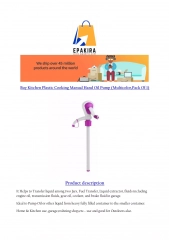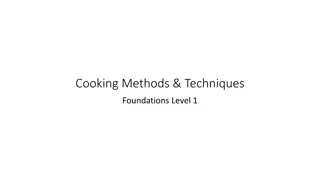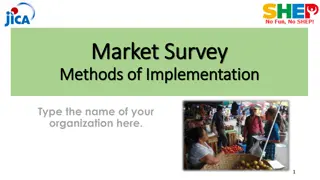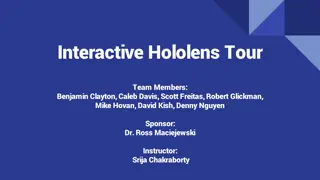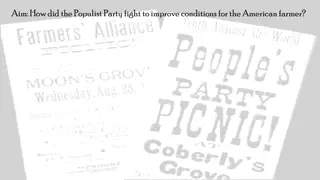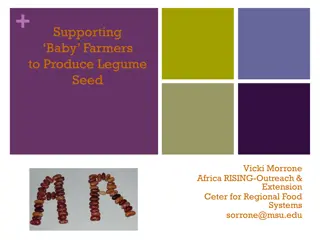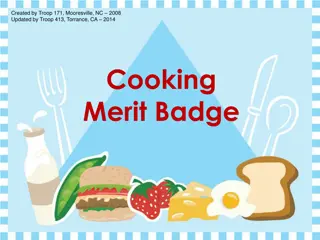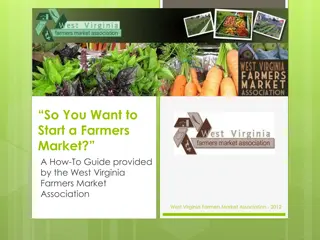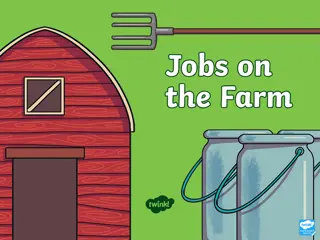Interactive Nutrition Education at Cooking Matters Farmers Market Tour
Cooking Matters at the Farmers Market offers interactive nutrition education combined with practical tips on budget-friendly, healthy shopping at local markets. Participants learn to utilize EBT/SNAP benefits, maximize discounts, and identify healthier food choices. The program aims to empower individuals to make informed decisions and save money while shopping at farmers markets.
Download Presentation

Please find below an Image/Link to download the presentation.
The content on the website is provided AS IS for your information and personal use only. It may not be sold, licensed, or shared on other websites without obtaining consent from the author. Download presentation by click this link. If you encounter any issues during the download, it is possible that the publisher has removed the file from their server.
E N D
Presentation Transcript
Cooking Matters at the FARMERS MARKET NATIONAL SPONSOR
Agenda Cooking Matters at the Farmers Market overview Before the tour Facilitating a Farmers Market tour After the tour Cooking Matters Presentation2
Cooking Matters at the Farmers Market Cooking Matters the Farmers Market tours offer participants interactive nutrition education paired with information about the farmers market and how to shop for healthy food on a budget at the farmers market. Tour participants will learn to: Use EBT/SNAP benefits at their local farmers market Use available discount and incentive programs Expand their food budget Use unit pricing Buy fruits and vegetables on a budget Identify whole grains Read food labels SAVE MONEY Share Our Strength s Cooking Matters3
Tour Objectives Cooking Matters Presentation4
Four Researched-Based Objectives of All Cooking Matters at the Store Programs Compare unit prices Identify 3 ways to buy produce Compare food labels Identify whole grains Share Our Strength s Cooking Matters5
Additional Objectives for Cooking Matters at the Farmers Market Tours Understand the differences between the farmers market and the grocery store How to save money while shopping at the farmers market Use SNAP/EBT and available discounts & incentive programs at the farmers market Share Our Strength s Cooking Matters6
Planning a Cooking Matters at the Farmers Market tour Cooking Matters Presentation7
Determine Where and When to Hold Your Tour Some things to consider: Market location and convenience for attendees Market hours-- each market varies Vendor variety at the market Variety in produce Multiple food groups (meat, produce, gains, dairy) Pick a market that accepts SNAP/EBT and/or has SNAP incentives Share Our Strength s Cooking Matters8
Planning the tour (3 weeks in advance) Pick a local market, visit market to learn more about: Incentive programs at the market How EBT/SNAP is processed at the market How many vendors are there, what they are selling Contact the market manager: Market managers are often farmers and are very busy people E-mail usually isn t the best way to contact market managers Face to face contact is best and allows for a more effective introduction to the program Always follow up via phone or e-mail with more information Share Our Strength s Cooking Matters9
Planning the Tour (2-3 weeks in advance) Set a time If it is a large and hectic market, it may be best to offer the tour during the slower hours of the market to avoid disrupting vendors Also take into consideration convenience for participants, even if it is a busier market time, perhaps earlier in the morning on a Saturday or later in the afternoon/evening on a weekday market Later market tours can highlight the discounts found at the end of the day, earlier market tours showcase the larger selection FILL OUT A TOUR SCHEDULING FORM! Share Our Strength s Cooking Matters10
Follow up with the market manager when you have set a date/time for the tour Remind market manager what is needed, if anything, from them. Examples: Can they give participants an introduction to the Market? Will they introduce you to market vendors to talk to throughout the tour? Do you need space to set up a table? 11
Outreach Print Flyers TARGETED OUTREACH is critical to reaching the low-income participants we desire Suggested outreach locations: Food pantries Community meal sites Community health centers Community centers Libraries Avoid recruiting directly at the farmers market until the day of, focusing on first time market goers and people who are less likely to shop at the market already Share Our Strength s Cooking Matters12
Tour participants do not receive a $10 Hannaford gift card. They get a bag and a book and additional handouts for participating. 13
Before the tour Cooking Matters Presentation14
Pre-Tour Checklist For the table: - Table - Tablecloth - Sign-up sheet for more information - Surveys - Whole Grains Handouts - Whole Grain Model - MyPlate Poster - Maine Seasonal Food Guide Handout - Food Label - Unit Pricing example (3 carrot Handouts) - Meatless Protein Handout - Plain yogurt container - Sweetened yogurt container with attached sugar packets Participant incentives: - Cooking Matters bags - Cooking Matters at the Store booklets Additional Material: - Pens - Clipboards Cooking Matters Presentation15
Day of the Tour Arrive to the market 1 hour before scheduled tour Find the Market Manager Introduce yourself Ask where to set up your table Ask the manager to introduce the market to participants again, you should have already mentioned this in previous communications Ask the manager/EBT booth volunteer to explain to participants how EBT/SNAP/debit/credit works at their market Make sure market manager and/or EBT booth knows how many more people you can accommodate for the day s tour, to fill in any open spots that day Registration Booth Set up table with information and organize materials Participant packets and incentives More information about Cooking Matters, SNAP-Ed, the market Share Our Strength s Cooking Matters16
Day of the Tour, continued.. Introduce Yourself to Vendors Walk through the market to introduce yourself to vendors Ask vendors if they are willing to tell participants more about their booth as you walk through the market. Pick one or two vegetable, one meat, and one dairy vendor Introduce their farm where is located? What do they grow/produce? What is the seasonality of those items? What do they see as a good value at their stand? Do they have tips about storing/preparing any of the unusual or bargain items? Once everything is set up, station yourself at the table to provide information and wait for participants to arrive Use this time to map out your tour knowing which vendors will participate Share Our Strength s Cooking Matters17
Leading Your Farmers Market Tour Cooking Matters Presentation18
Introductions: To the Market and Each Other Welcome everyone to the market Introduce yourself, and explain what you will be covering in the tour Have participants introduce themselves to you/each other Ask the market manager to tell the participants more about the market When the market is open (season, dates, times)? Any programs or educational resources available for shoppers Have booth attendant explain process for using EBT at the Farmers Market and any incentive programs going on at the time - Encourage participants to ask questions for clarification, if possible, have a few questions for participants who are shy or don t know what to ask Ensure that if eligible participants are not currently receiving SNAP benefits, information is provided on how to sign up Hand out Participant Packets to refer to throughout the tour Cooking Matters Presentation19
Talking Points: Produce Start with the laminated MyPlate and ASK participants if they are familiar with MyPlate. SHARE That MyPlate is the new food pyramid (if participants are older, they may not be familiar with MyPlate but will know the food pyramid) Highlight that of the plate is fruit and vegetables, plus grains makes of the food on the plate plant foods Only of the plate is protein, and this includes both plant and animal protein ASK Participants if their plates typically look like this? Explain that most often our plates do not, but it is a good image to have in your mind when preparing and shopping for food. This applies to carts and shopping bags, not just plates. Remember, the food fills up your carts and bags before it makes it to your kitchen/plate. Share Our Strength s Cooking Matters20
Talking Points: Produce Start by explaining there are multiple ways to get fruits and vegetables into our diet. ASK Participants to list the ways that we purchase vegetables and fruits (fresh, frozen, canned, and dried), which forms they usually purchase, and why? SHARE That today s tour will focus on fresh, but other forms are available at the famers market. Explain that one is not necessarily better than the others. SHARE That it is always best to walk through the entire market before making selections Not all farmers grow the same variety of items Not all farmers price their products the same SHARE: Shopping early or late can sometimes yield the best deals You might have a better selection in the morning You might find better deals at closing time as farmers are getting ready to pack up and leave Share Our Strength s Cooking Matters21
Talking Points: Produce ASK Participants what they look for in fruits or vegetables at the super market? SHARE The differences between purchasing produce at the farmers market Bigger isn t always better! Lots of produce is better when it s smaller, ex: strawberries Perfect looking isn t always better, and does not ensure good taste Blemishes on the exterior often don t effect the inside or the taste Don t reject items because they have dirt and mud on them, wash them! SHARE Always ask vendors if you have any questions or concerns about an item they are selling There is no such thing as a dumb question Farmers are great resources Ask about produce you have never seen before Ask for suggestions about how to store or prepare different items Share Our Strength s Cooking Matters22
Talking Points: Produce ASK Participants if they have ever selected a fruit or vegetable at the store only to get home and find it wasn t ripe or went bad very quickly? SHARE As you walk through the market, demonstrate judging ripeness on available produce, or ask vendors to help you. For example: Strawberries nice red color, small to medium size is often sweetest, firm but not hard, not mushy Potatoes firm, skin should not move when touched Tomatoes and peppers vibrant color, firm, no sagging skins ASK About a time they have successfully substituted an ingredient in a recipe? SHARE: It is always best to go to the farmers market with an open mind, flexibility can save you money. Designate a farmers market budget to stay within your own food budget Plan meals ahead of time and make a list direct participants to the Meal Planning 101 and Meal Planning Worksheet handouts Note what meals items will be used for, to know when you can make substitutions Share Our Strength s Cooking Matters23
Talking Points: Produce ASK Participants what tips or tricks they use to save money at the grocery store? Could any of these be used at the farmers market? SHARE Tips for saving money at the farmers market direct participants to the Saving Money at the Farmers Market hand out Refer to different points on the worksheet Larger/bulk purchases can be requested and often result in a reduced unit cost. It can save you lot of money to purchase in bulk. Freeze or can the additional produce for winter when farmers market produce is unavailable. Do not hesitate to ask the vendor to buy smaller quantities than the amount on display. Explain that this may result in slightly higher price but if you do not have a lot of money to spend that day, or you will not use/preserve the extra quantity it is the best option. Share Our Strength s Cooking Matters24
Talking Points: Protein ASK What are some sources of protein we could purchase at the farmers market? SHARE The farmers market is a great place to find different sources of protein including beans, eggs, poultry, and red meat. - Point out which vendors participants can find meat, eggs, and/or beans at this market SHARE The pros and cons of buying meat and eggs at the farmers market. Pros: Knowing where the animals were raised, being able to ask farmers questions about how they were raised, what they were fed, etc. Cons: Less selection, often times a bit pricier than the supermarket ASK Participants if they have ever noticed the difference in the unit price of whole vs pieces of meat? SHARE Just like in the grocery store, items that have been processed are usually more expensive at the farmers market. Share Our Strength s Cooking Matters25
Talking Points: Protein ASK If participants know how to recognize freshness in meat? SHARE Tips for determining whether or not meat is fresh color, firmness. SHARE Tips for choosing meats with lower fat content. - Looking for meat with less marbling - Looking for lean cuts of beef and pork hat include round , loin , or leg in the name (ex: pork loin chops, sirloin) ASK Participants to share their favorite sources of protein, including non-animal sources of protein. SHARE Your favorite sources of plant protein, and some suggestions for increasing plant protein into their diets how do you use beans, nuts, and high protein grains? Share Our Strength s Cooking Matters26
Talking Points: Dairy SHARE Most farmers markets in Maine have at least one vendor selling dairy products. SHARE Compare/contrast differences between milk at the grocery store and the farmers market, including price. ASK If participants consume dairy products, what types of dairy products do they consume? What type of milk do they usually purchase? SHARE The difference between whole, 2%, 1%, non-fat options. SHARE Explain that the sell by or Best if used by dates on dairy products are the last date on which the product should be sold and do not mean the product is spoiled. Share Our Strength s Cooking Matters27
Talking Points: Whole Grains SHARE Many farmers markets in Maine have bakers that sell whole grain products, point them in the direction if there is one at this market. To find out whether or not a product is whole grain at the farmers market, all you need to do is ask the baker whether or not the product was made with 100% whole grain flours Look for sales on day old breads Bread can be frozen if it won t be used right away *Walk with participants back to registration station to discuss whole grains and label reading* SHARE The difference between whole grain flours and refined flours, what is removed in the process and why whole grains are important. Whole grains have a higher fiber content Fiber helps keep you full longer, helps regulate blood sugar Just because bread is brown does not mean it is whole grain Share Our Strength s Cooking Matters28
Talking Points: Label Reading *Have a sample label for a whole grain bread and a non-whole grain bread Ask participants to identify the whole grain bread Discuss how they knew it was a whole grain Compare fiber content and review daily fiber needs for adults (21-25g for women, 25-35g for men) Explain that fiber is only found in plant foods SHARE That although most items at the farmers market do not have nutrition labels on them, many of the store-bought foods we serve them with do. Use the bread labels and canned bean labels to talk about label reading, pointing out fat, sodium, protein, fiber, and sugar Remind participants about the %DV rules: 5% or lower is considered low, 20% or higher is considered high Share Our Strength s Cooking Matters29
Optional: Taste tests and Samples If you would like, you can provide taste tests or samples at your own booth to highlight healthy, low cost dishes using ingredients at the market. If you choose to do this, include recipes and shopping lists for the recipes you use, so participants can conveniently grab the items during their $10 Farmers Market Challenge Activity. Sample recipe suggestions: Tabbouleh, Tomato and Cucumber Salad Share Our Strength s Cooking Matters30
Activity: Find the Best Buy This activity is designed to encourage participants to use unit pricing to compare prices between vendors at the farmers market. Instruct participants to compare the prices for at least three different produce items while they shop around the market. Participants must return this worksheet to the facilitator at the end of the tour. Share Our Strength s Cooking Matters31
Activity: Farmers Market Challenge This activity is meant to guide participants while they shop for the $10 challenge. It also helps us document what they are purchasing, because the receipts we receive only include the amount spent at each vendor. This provides a guideline, and makes for an interesting activity but participants are not required to purchase something from the list, especially if they will not use it. *The most important thing to note is that convenience foods, sugar sweetened beverages, and sugary baked goods are not to be purchased with the $10 provided 32
Wrap up & Surveys After participants complete the farmers market challenge and their shopping, have them meet back up at the registration table to reflect on lessons learned and fill out the Cooking Matters at the Store Surveys. ASK About participants observations about pricing, variety, and new foods discovered. ASK If participants have any further questions. Have participants complete the Cooking Matters at the Store Survey. Share Our Strength s Cooking Matters33
End of Tour Fill out a Tour Reporting form and email to Courtney at ckennedy@gsfb.org. 34
Questions? Share Our Strength s Cooking Matters35



